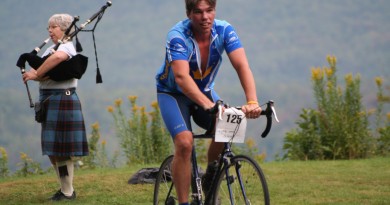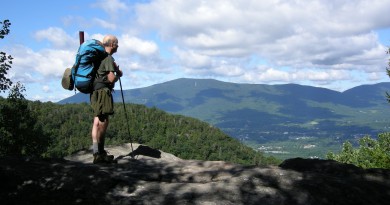Ice is nice…
By
Jamie Hess
Posted November 1st, 1999
…especially if you’re a speedskater.
What exactly is speedskating?
Long track or short track?
Clapskates or fixed heels? Natural ice or artificial ice? Ask 10 skaters and you’ll get 10 different answers. You’ll also find there aren’t enough speedskating opportunities in Vermont.
But that’s about to change. For 20 years the Green Mountain Speed Skating Club (GMSSC) has trained champion skaters in western Vermont. Now eastern Vermont is showing signs of life, too. On Saturday, November 6th, 7:30 p.m., the Twinstate Speedskaters will present a “Skating Expo” at the Hartford High School rink in White River Junction. If you’ve never speed-skated before, this is your chance to watch experienced skaters in action, or step out onto the ice yourself and try this exciting sport. The show is open to the public, with free admission, free lessons, and free speedskate rentals.
Speedskating comes in three flavors: Short track, long track, and marathon. Short trackers skate indoors on a hockey rink, preferably an Olympic-size rink. “Packs” of skaters circle the rink at amazing speeds over distances of 500 to 1500 meters. Short trackers wear helmets, gloves and pads, and special skates with the blades offset sideways on the boots for improved cornering. GMSSC holds weekly short track workouts at Riley Rink in Manchester, Friday evenings at 5:45 from late October to mid-March. GMSSC skaters also show up Wednesday mornings at 9:30 for public skating at Cairns Arena in So. Burlington.
Long track skaters race distances up to 10K on a 400-meter “oval” laid out like a running track. Most long trackers use “clapskates” with blades that hinge at the front, like cross-country ski bindings. There are only three long track ovals in the entire United States, but luckily for Vermonters, one of them is the Olympic Oval in Lake Placid, a relatively short drive away.
In contrast, Canada has dozens of ovals in Montreal, Quebec City, Ottawa, and many smaller cities. Here in Vermont, the Catamount Family Center in Williston has a 250-meter outdoor oval—not quite long track, but close enough. GMSSC long-track skaters work out at Catamount from December to March.
What really turns on a lot of Vermont skaters is the opportunity to marathon skate outdoors on 100 percent natural ice. When a hard freeze comes in on the heels of a midwinter rain, followed by a bright sunny day with light winds and temperatures in the upper 20s, it’s a skater’s paradise. Head for the largest lake or river you can find, put on your skates, and GO! Every winter, these conditions occur at least once. Some years the smooth ice only lasts two or three days. Other years—like last winter—it stays for weeks.
Marathon skating is extremely popular in northern Europe. In the Netherlands, people wait for decades for a chance to skate the canals of Friesland on the fabled 200-kilometer Elfstedentocht. Only 16,000 skaters are allowed to participate, and the waiting list numbers tens of thousands more.
One of the reasons Europe has so many marathon skaters compared to the U.S. is their dedication to ice maintenance. Dutch fanatics literally transplant ice into thin spots on the canals. Sweden has more reliable ice, but snowfall can be a problem. The Swedish solution: Plowed skating tracks, up to 10 miles long, on all the lakes around Stockholm. Ice maintenance could work equally well in Vermont if enough skaters got together and worked for it.
You can marathon skate on just about any kind of skates, but long blades and comfortable boots are best. Skating and skiing have hybridized in recent years. First, the advent of skate-skiing made high-top boots and stiff-flex bindings available for the first time. Now, marathon skaters have incorporated a ski binding onto a detachable ice blade. So you can speedskate in comfortable cross-country ski boots. Detachable long blades are also available to fit telemark ski boots, or even ordinary hiking boots.
Another European advance is the development of specialized ice safety equipment, including “ice poles” for testing ice thickness and strength.
Skaters always travel in groups. They all carry “ice claws” and floating lifelines, so they can rescue each other in an emergency. And they wear backpacks full of dry clothes, sealed in airtight plastic bags for extra flotation, should they fall through the ice.
There are several places to marathon skate in Vermont, although no matter how tempting, Lake Champlain is NOT one of them, since it rarely freezes solid except in the shallow bays and coves. Better choices are Shelburne Pond, Lake Dunmore, Wrightsville Reservoir, and Caspian Lake. In eastern Vermont, try Lake Fairlee and Lake Morey. The Connecticut River often has excellent ice on the 25 miles of flatwater between Norwich and Bradford, but an experienced guide and safety equipment are mandatory. In New Hampshire, one of the best destinations is Lake Sunapee, just off Interstate 89 near New London—10 miles long, with islands, lighthouses and 2700-foot Mount Sunapee towering over the south end of the lake. Farther afield, Canadians maintain plowed skating tracks on the five-mile Rideau Canal in Ottawa, and the Riviere L’Assomption in Joliette, Quebec, northeast of Montreal.
How do you tell when the ice is safe? Most skaters wait until it’s four inches thick. You can drive a car on four inches of ice—but you won’t catch me doing that. I’ll be out skating instead. Hope to see you on the ice this winter!
For more information on speedskat-ing in Vermont: Green Mountain Speed Skating Club, Matt Glerum 802-362-0127 (eves.), or glerumm@sover.net, or www.uvm.edu/~pnewbeck/gmssc.htm. Twinstate Speedskaters, Jamie Hess 802-649-3696 (eves.), jamie@nordicskater.com.


